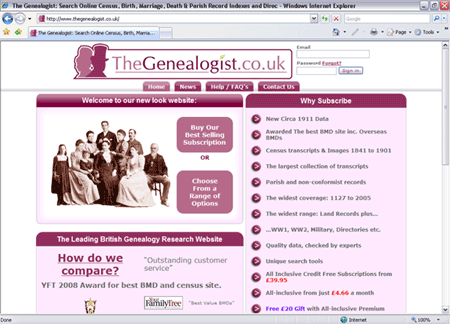Website of the Month
"This site happily escapes the common problem of scrambled census surnames." |
TheGenealogist
Part of the S&N Genealogy Supplies' empire, TheGenealogist is an online records-searching website offering access to genealogical data. Its current collections - new material is being added monthly - include UK censuses, births (including pre-1837) marriages, deaths, land records, military records, directories, parish records, and non-conformist records.
Claiming the largest collection of census transcripts for England and Wales, TheGenealogist offers records for 1841-1871 and 1891-1901 as part of an all-inclusive subscription. These exclude 1881 as this year is already available elsewhere free of charge. These records have links to the original page images as well as transcripts of the household and the family, which can be searched by name, age, occupation, relationship to head of household, and birthplace.
 One of the common problems with the census sites is that surnames get scrambled either during enumeration or transcription and searchers can lose their chance of finding their family forever. This site happily escapes this by allowing users to search by groups of forenames of three or more family members (living together), which may find them. The site also allows a search for name variants and different spellings; for any nicknames that may have been used, like Nellie for Ellen/Eleanor/Helen; or by street or house. One of the common problems with the census sites is that surnames get scrambled either during enumeration or transcription and searchers can lose their chance of finding their family forever. This site happily escapes this by allowing users to search by groups of forenames of three or more family members (living together), which may find them. The site also allows a search for name variants and different spellings; for any nicknames that may have been used, like Nellie for Ellen/Eleanor/Helen; or by street or house.
TheGenealogist has BMD records, indexed from the start of civil registration to 2005, for the whole of England and Wales. For records from 1984 on, there's a unique search tool, SmartSearch, which uses an intelligent search system to perform a reverse look-up. It can, for example, search for the children born to a couple using the father's surname and the mother's maiden name; see the details for either partner in a marriage; or find a birth record from a death record. For records prior to 1984, the indexes are in the form of lists by surname, forename and birthplace, which have now been digitized and indexed. Finding a name on a page is by inspection and if you have only a vague idea of a date it can be a lengthy business.
You can also produce a surname distribution map to see where your family name was to be found in the years for 1841 to 1901, which might prompt you where to look next if you're stuck.
Other resources you can search include historic books back to 1127; parish records from 1538 (when they began) to 1837; pre-1837 birth certificates from registries and non-conformist (Quaker, Baptist, Methodist) records back to the 1600s; directories from 1852 to 1905; and the Electoral Roll for London 2005. You can find WWI and WWII military Rolls of Honour and, if you're from those strata of society, landowner records and information on Knights of England back to the 12th Century. Some of these databases are currently incomplete, but updates are being made every month.
In brief: five things you need to know |
- The site can be accessed by a variety of subscription and pay-as-you-go payment options.
- Census transcriptions can be searched in a number of unique ways, including by nickname.
- You can look at surname distribution maps.
- SmartSearch (for searching BMDs
since 1984) allows you to perform reverse look-ups, i.e. find children by their parents' names.
- You can put your tree online using TreeView function.
|
There are several ways of getting your hands on this information. One option is to take out a subscription. An all-inclusive Personal Premium plan, at either £68.95 annually, or £39.95 six-monthly, buys unlimited access, payable in advance (libraries and family history societies pay less). This is currently cheaper than some competitors. Or you can buy a Personal Plus subscription, which costs less but rations your access by allocating 'credits' monthly. This is £55.95 annually for 800 credits. There are also two quarterly-payment subscriptions, where different searches cost differing numbers of credits.
Alternatively you can pay-as-you-go by purchasing a limited number of credits and 'topping-up' only when needed. Although not so cost-effective, this may be more economic for more casual use. Most of these options involve a commitment for a minimum 12-month period.
If you want to, you can also publish your own family history using TheGenealogist's TreeView, either by making entries online or uploading your GEDCOM file. In return, you get your data sorted into pages showing individuals, families, facts and events; sources and citations; repositories; and notes. By default your tree is private to protect your information but you have the option to change your privacy settings and invite friends or relatives to view it as well.
There's a subscriber section where you can join in various forum discussions, read articles from fellow family historians, and perhaps contribute your own (if you have an all-inclusive subscription) and win a prize. There are articles by professional genealogy writers offering hints and tips too. Elsewhere you can keep a research log, noting details of the people you have found and adding various records.
Reproduced from an article by James Taylor in Family History Monthly |